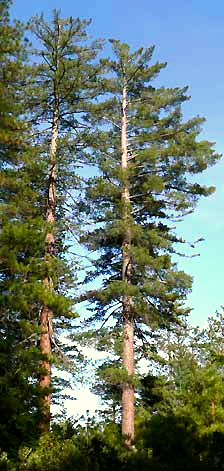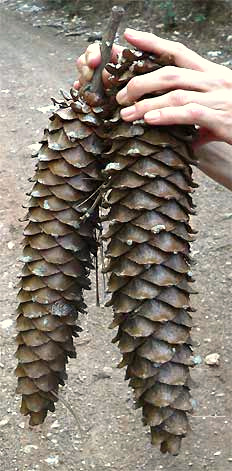from the May 22, 2005 Newsletter issued from the Sierra Nevada foothills
somewhat east of Placerville, California, USA
SUGAR PINES  We're at about 2600 feet here and the forest is dominated by Ponderosa Pines. Between here and the mailbox the road I jog on each morning dips into a valley where Digger Pines begin appearing. Digger Pines dominate the lower, drier elevations. By the same token, on our coral-root hike we were a couple hundred feet higher in elevation and in rainier territory, and there Sugar pines were about as numerous as Ponderosas. Here we say we're "going down into the Digger Pines," and "going up into the Sugar Pines." Let me tell you about those Sugar Pines, PINUS LAMBERTIANA, two of which are shown at the right.
We're at about 2600 feet here and the forest is dominated by Ponderosa Pines. Between here and the mailbox the road I jog on each morning dips into a valley where Digger Pines begin appearing. Digger Pines dominate the lower, drier elevations. By the same token, on our coral-root hike we were a couple hundred feet higher in elevation and in rainier territory, and there Sugar pines were about as numerous as Ponderosas. Here we say we're "going down into the Digger Pines," and "going up into the Sugar Pines." Let me tell you about those Sugar Pines, PINUS LAMBERTIANA, two of which are shown at the right.
Sugar Pines are famous for being the tallest US pine (up to 200 feet tall) and for producing the longest cones of any American conifer (up to 26 inches long). Lower down the page you can see a couple of long cones being held by Diane.
Sugar Pines are members of "the White Pine group," and therefore on the stems the needles cluster in bundles of five. The authors of "Sierra Nevada Natural History," Tracy Storer and Robert Usinger, say very prettily of the Sugar Pine, "A big mature Sugar Pine on a mountain crest, with long cones hanging at the ends of its spreading branches, conveys the feeling of a beneficent patron." Well, here I'm slope-bound with no mountain crests at hand, but I can just imagine what they're talking about, and someday when it warms I'm hiking upslope until I see such a patron-pine.
 Of course I'm always comparing our pines here with the Loblollies back in Mississippi. Both Ponderosas and Sugars produce trunks that to my Southeastern- biased mind seem much too large for the amount of green branches the trees bear. It would seem those Loblollies, having so much heat and rich soil, would produce the largest trunks. I suspect that what's happening is that the trees here grow much slower. They have larger trunks, but they take longer to produce trunks of a given size than fast-growing Loblollies.
Of course I'm always comparing our pines here with the Loblollies back in Mississippi. Both Ponderosas and Sugars produce trunks that to my Southeastern- biased mind seem much too large for the amount of green branches the trees bear. It would seem those Loblollies, having so much heat and rich soil, would produce the largest trunks. I suspect that what's happening is that the trees here grow much slower. They have larger trunks, but they take longer to produce trunks of a given size than fast-growing Loblollies.
The "sugar" part of Sugar Pine's name derives from the fact that fire and physical wounds cause a kind of resin to seep out that hardens into white nodules. If you're hard up for chewing gum, this can be chewed, and it is actually slightly sweet.